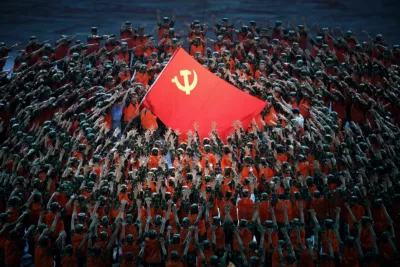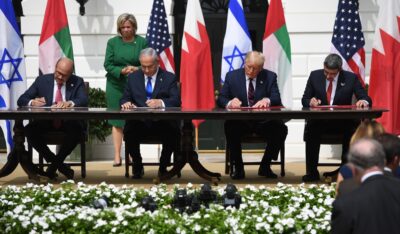Chinese Hegemony, Economic Ties and National Security
Abstract: In recent decades, China has fast emerged as a rising regional if not global superpower with its military spending and technological advances among the best in the world. Simultaneously, the nation has also been taking a more aggressive and pro-active foreign policy to establish its presence globally. Amidst these ventures, it is natural that the nation would come face to face with several state and (armed) non-state actors. Despite many such encounters, the current scholarship does not often study the broad approach that China adopts to such groups.
China’s foreign policy and approach to armed non-state militant actors diverges from the methodology adopted by Western nations such as the United States among others. This paper examines China’s approach to these groups specifically looking at Hamas, Hezbollah, and the Taliban (before it took power in Afghanistan). It offers a brief history of how China has engaged with these groups or used them to its own benefit.
It then argues that the nation’s policies toward such groups are mainly guided by trade, anti-Western sentiments and national security. This paper is intended to inform policy makers and scholars on how China views such actors and vice versa.
Introduction 
Since the ascension of the Chinese Communist Party (CCP) as the ruling party of China in 1949, the country has gone through many phases of domestic and international development. While China was treated as a pariah throughout the Cold War due to its communist ideology, since its opening up to the world in the 90s it has grown to be the second largest economy in the world just behind the United States and is now among the most dominant actors in the world, even leading the way in fields such as 5G technology, among others. [i]
In its quest to become one of the strongest powers of the world, its approach with various nations and armed non-state actors have been calculated and rigorous. This brief therefore explores the driving factors behind Chinese ties with violent non-state actors designated as terrorist groups by a significant number of nations globally. Specifically, it studies China’s relation with Hezbollah (designated as a terrorist group by many Western nations), Hamas and the Taliban (before it ascended to power in 2021), all three being violent Islamist organizations.
The brief is organized as follows, first it studies the three different groups in depth explaining the history as well as developments that have taken place over the past decades. In each of these case studies, it illustrates the factors that prompted China to take certain steps to either align with or move away from such militant actors. Subsequently, it summarizes the larger factors that drive China’s approach to such groups while also providing a brief insight into the type of armed non-state actors that have antagonized China before concluding the paper.
Specifically, this brief argues that China’s desire to see itself as a global superpower impacts its decisions to collaborate or eschew these groups. Under this overarching goal, China’s anti-US stance, its economic interests in the form of its Belt and Road Initiative (BRI), and its national security are the strongest driving factors in its policy towards armed non-state actors in the Muslim world.
The Taliban – Visible but cautious growth 
The Taliban has always been one of the biggest militant groups operating in Afghanistan. Having risen out of the ashes of the 1980 Russian invasion of Afghanistan and the subsequent Afghan Civil War, it garnered global attention when it ruled Afghanistan for a few years between 1996 and 2001.[ii]
The group fell into disarray when the US invaded Afghanistan in retaliation for not handing over Osama bin Laden who was hiding in their territory after the 9/11 attacks.[iii] Despite a significant military campaign against the group, it sustained itself by recruiting from disenfranchised populations and taking advantage of the poor corruption-ridden government of Afghanistan which did not improve the economic and socio-political situation of the citizens as well as the popular anger towards the US’ unjustified invasion of Afghanistan. [iv]
In August 2021, the group regained control of Afghanistan and re-started its rule with countries begrudgingly beginning to accept its legitimacy (in some cases, for a lack of a better option). China, however, was more open to a discussion with the Taliban, with some of the group’s leaders even visiting the nation in 2021.[v] Several questions arise from this and subsequent exchanges regarding the relationship between the two parties.
The answer to these questions lies in Afghanistan’s geo-strategic importance, China’s past ties with the Taliban and the presence of various anti-Chinese militants in Taliban controlled territories. Afghanistan, which is largely within China’s backyard, has been an important country for connecting China to the Middle East with Central Asia being one of the connectors between China and Afghanistan. As such, China has long set its eyes on Afghanistan as a major investment hub to increase connectivity especially for its Belt and Road Initiative.[vi]
In addition, given Afghanistan’s position in its backyard as well as sharing a small border with China, the latter has always feared for its own security. In the late 1980s, this translated into militarily funding the Mujahideen to prevent Russian forces from establishing a foothold in its sphere of influence.[vii] This was China’s first contact with the Taliban. However, these ties petered out by 2001 after which China simply cut ties with the group to avoid any trouble with the anti-Taliban coalition of Western nations.[viii]
However, perhaps the most important issue in the relationship has been that of Uyghur militants. Throughout the 2000s, Uyghur militants used their presence in Taliban-ruled areas to launch attacks on Chinese targets. China has long controlled the Uyghur Muslim population in the Xinjiang province and has been accused of rampant oppression of citizens there. The Uyghur issue has long been a sensitive subject for China which has blocked any discussion on this issue by international observers.[ix]
One result of its oppression of Uyghur Muslims has been the fleeing of Uyghurs to parts of Central Asia and Afghanistan where they formed Jihadist groups and coalesced under a larger movement called the East Turkistan Islamic Movement (ETIM), which later became the Turkistan Islamic Party.[x] Uyghur militants have perpetrated many attacks against China not only in Afghanistan, but also in parts of Central Asia. Given that many of these groups were also operating out of Taliban-controlled territories in Afghanistan, keeping them under control has been one of China’s main concerns regarding the Taliban.[xi]
In the 2000s, because China did not have any official contacts with the group, it relied on the two’s mutual ally Pakistan to push the Taliban to rein in Uyghur militants. To this end, Pakistani officials even took Chinese diplomats to Afghanistan to meet with Taliban leaders. However, despite the Taliban stating that it did not support the Uyghurs in any way against China, various reports from organizations like the United Nations disproved these claims. [xii]
As such, China has been quite cautious in trusting the Taliban. In many ways, for China, its three main biggest security problems have been separatist violence, ethnic nationalism, and Islamist terrorism.[xiii] In Afghanistan, all of three of these problems converge creating epic security problems for China. Much of this could have been avoided by the Taliban given that it controlled territory. This explains why, despite many commentators noting that China would step in to fill the vacuum left by the US in Afghanistan, it has not done so even in 2022.[xiv]
Indeed, as some have observed, Chinese interests, personnel and investments which were not protected previously, continue to face threats even in a Taliban-controlled Afghanistan. This is mainly due to China’s perception that the Taliban is unwilling to control Uyghur militants with which it ideologically agrees or is incapable of fighting given its massive governance challenges.[xv]
What stands out here for is China’s approach to the Taliban’s record of human rights vis-à-vis how the West views the Taliban. For nations like the US and others European nations, the Taliban’s actions against women and its brutal killings of countless Afghan and other citizens are a major moral issue and a problem area when it comes to disbursing aid.[xvi] China, on the other hand, pursues a policy whereby it does not interfere in Afghanistan’s domestic affairs and especially does not comment on the Taliban’s human right violations as long as the Taliban reciprocates this policy of non-interference.[xvii]
Verbally at least, this policy reaped rewards with Taliban spokesperson noting in 2021 that China’s issue with the Uyghurs was an internal Chinese issue that he could not comment on too much (although attacks against Chinese personnel have continued). [xviii]
It is this policy of mutual non-interference that has made China a significant power broker in Afghanistan since the 2010s (where it was also on good terms with the regime). While China’s relationship with the Taliban was heavily influenced by its friendship with Pakistan, China began to hold an independent relationship with the Taliban since 2014 having hosted Taliban on five different occasions for peace talks and mediations and continuing contact with the group outside of these meetings too.[xix]
This forms another leg of China’s foreign policy initiative in (especially) conflict-ridden nations where it tries to act as a cordial actor that can mediate conflicts by being friendly with all parties.[xx]
Thus, as can be seen here, of all the three groups we examine, the Taliban are the geographically closest to China, leading to more areas where the two parties have intersected. Largely, while China’s trade ambitions in the form of the BRI have given it some impetus to invest in relations with the Taliban before and after it controlled Afghanistan, the Taliban’s unwillingness to acknowledge that Uyghur militants still exist in its territory frustrates these goals.[xxi]
Thus, China’s relationship with the Taliban is likely defined by its paradox of wanting to increase its economic footprint in Afghanistan such as in lithium mining,[xxii] while also avoiding security threats to its interests. In addition, China’s engagement with the Taliban also falls within the scope of Chinese conflict resolution efforts in the war-torn nation will also continue to pursue a policy of mutual non-interference in domestic political affairs.
Hamas: An Instrument of Anti-US Posturing 
Hamas has been branded as a terrorist organization by most Western nations such as the US, EU nations and the UK.23 Understanding the broader Chinese involvement in the Israel Palestinian conflict is key to understanding the nation’s engagement with Hamas.
An interesting aspect of China’s engagement in the Israeli Palestinian conflict has been its ideological history and evolution of its policy over time while retaining some of the symbolic trapping of its past position. In the early 1950s, China criticised the Israeli presence in Palestine as a colonial presence. This was in line with its anti-colonial stance that it took all over the developing world. In fact, its support for the Palestinian cause was so strong that it even armed the Palestinian Liberation Organization (PLO) in the 60s to fight against Israel.
It was only after the death of General Mao Zedong in 1976 that this foreign policy shifted to one less ideologically-driven and more pragmatic. Accordingly, China scaled down its financial and military support to Palestine and opened relations with Israel. However, co-operation between the two nations were largely behind the scenes as seen in the 1980 Russian invasion of Afghanistan.
Both countries held secret collaborations in their common goal to arm Afghan Mujahideen against the Russians since China (as mentioned in the previous section) opposed the Russian presence in its backyard and Israel was likely motivated to oppose the Russian presence by its alliance with the United States.
It was only in 1992 that China officially opened an Israeli embassy in Beijing. Since then, trade ties have skyrocketed from 50 million USD in that year to about 15 billion USD by 2020 making China one of Israel’s biggest trading partners.26 In addition, China has also been a major beneficiary of Israeli weapons technology long before officially establishing ties.
For instance, in the 1980s, Israel was a major force in modernizing Chinese military as it provided Western technology that was otherwise forbidden to be sold to China directly from the West, which marked a massive upgrade to China’s Soviet-provided defence equipment. This relationship evolved to the point where Israel is now China’s top defence supplier after Russia, making special inroads into its relationship with China.
Yet despite all of these factors, China has often proven to be in support of even groups like Hamas, which it has refused to designate as a terrorist organization. Indeed, as part of its outreach to the Muslim world, China has even engaged with Egyptian and other Arab authorities with the goal of ‘freeing Palestine.’28
While China has had several suggestions regarding the conflict, its suggestion to empower other factions within Palestine (such as Hamas) to ensure reconciliation and dialogue between these groups is of consequence. This is a move that is directly opposed to Israeli interests given how Hamas has always been more aggressive toward Israel compared to the ruling government in the West Bank, the Palestinian Authority (PA).
Here the driving factors behind China’s approach to Hamas and its mediation of the broader conflict has been its opposition to American hegemony. Specifically, China’s biggest pet peeve is the United States’ singling out its treatment of the Uyghur Muslims in its Xinjiang region as a human rights violation. By positioning itself as a champion of Palestinian rights and demonstrating the United States’ unwillingness to alleviate the problems of the Palestinians who are in a similar position to the Uyghur Muslims, China intends to call out American hypocrisy in its discourse of human rights.
In that respect, some of China’s posturing regarding Israel is more related to its antagonism towards the United States rather than just Israel. This is why it called out the US for blocking UNSC action that would speak to Israel in one voice during the 2021 escalation of tensions between Israel and Hamas. In fact, Chinese Foreign Minister Wang Yi also noted how China had raised the issue of Palestine five times during its time as chair of the UNSC as a means to revive discussions about the conflict and show that it also cares about the Muslim world.
Secondly, Israel is also quite invested in carving out a bigger space for itself in the global arena in anticipation of a multipolar world and its own rising economic and military status. In this regard, it has often offered to hold peace talks for both parties if they were interested. This view also reflected by its diplomat Qian Minjian who noted that one major driver of Chinese foreign policy in the Middle East region is to encourage conflict mediation for the various tensions in place.

 Mohammed Sinan Siyech
Mohammed Sinan Siyech